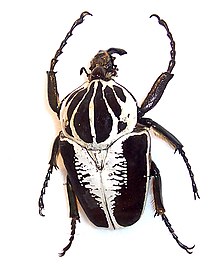
Back خنفساء جالوت Arabic خنفساء جالوت ARZ Goliathus BE Escarabat goliat Catalan Goliathus CEB Goliathus Czech Goliathkäfer German Goliathus Spanish سوسک جالوت FA Goliathus Finnish
| Goliathus | |
|---|---|

| |
| Goliathus regius | |
| Scientific classification | |
| Domain: | Eukaryota |
| Kingdom: | Animalia |
| Phylum: | Arthropoda |
| Class: | Insecta |
| Order: | Coleoptera |
| Suborder: | Polyphaga |
| Infraorder: | Scarabaeiformia |
| Family: | Scarabaeidae |
| Subfamily: | Cetoniinae |
| Tribe: | Goliathini |
| Subtribe: | Goliathina |
| Genus: | Goliathus Lamarck, 1801 [1][2] |
The Goliath beetles (named after the biblical giant Goliath) are any of the six species in the genus Goliathus. Goliath beetles are among the largest insects on Earth, if measured in terms of size, bulk and weight.[1][2] They are members of subfamily Cetoniinae, within the family Scarabaeidae.[1] Goliath beetles can be found in many of Africa's tropical forests,[1] where they feed primarily on tree sap and fruit.[1][2] Little appears to be known of the larval cycle in the wild, but in captivity, Goliathus beetles have been successfully reared from egg to adult using protein-rich foods, such as commercial cat and dog food. Goliath beetles measure from 60–110 millimetres (2.4–4.3 in) for males and 50–80 millimetres (2.0–3.1 in) for females, as adults, and can reach weights of up to 80–100 grams (2.8–3.5 oz) in the larval stage, though the adults are only about half this weight. The females range from a dark chestnut brown to silky white, but the males are normally brown/white/black or black/white.[1] Goliath beetles, while not currently evaluated on the IUCN Red List, are facing growing conservation challenges across their African range due to habitat loss, over-collection for the international pet trade, and the potential impacts of climate change.[3]
- ^ a b c d e Goliathus - The African Goliath Beetles
- ^ a b Karl Meyer Goliathus Breeding Manual
- ^ Dendi, Daniele; Ajong, Stephanie N.; Ségniagbeto, Gabriel Hoinsoudé; Amori, Giovanni; Eniang, Edem A.; Fa, Julia E.; Demaya, Gift Simon; Lado, Thomas Francis; Luiselli, Luca (2023). "Detecting declines of West African Goliath beetle populations based on interviews". Journal of Insect Conservation. 27 (2): 249–259. Bibcode:2023JICon..27..249D. doi:10.1007/s10841-022-00447-7.